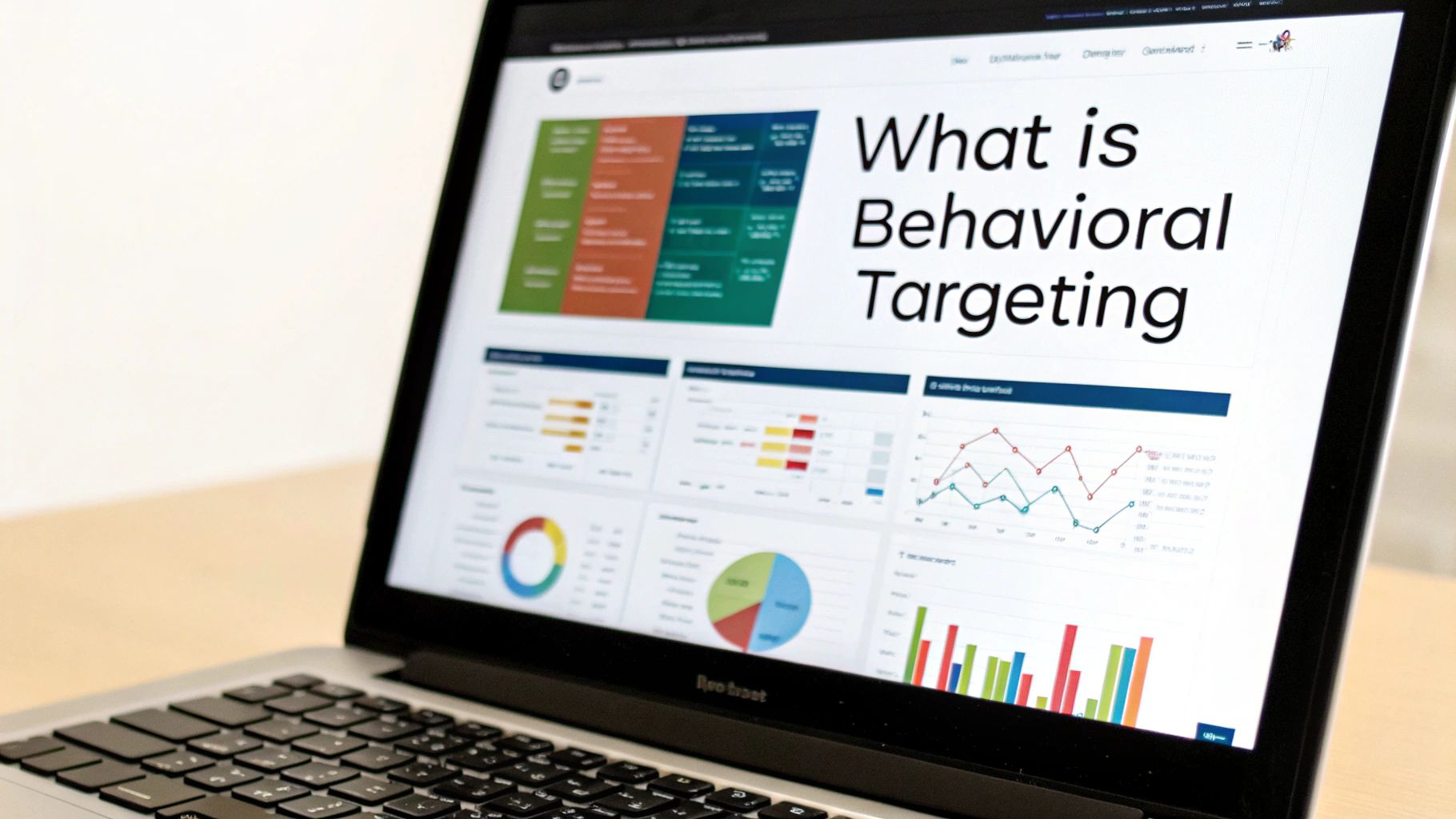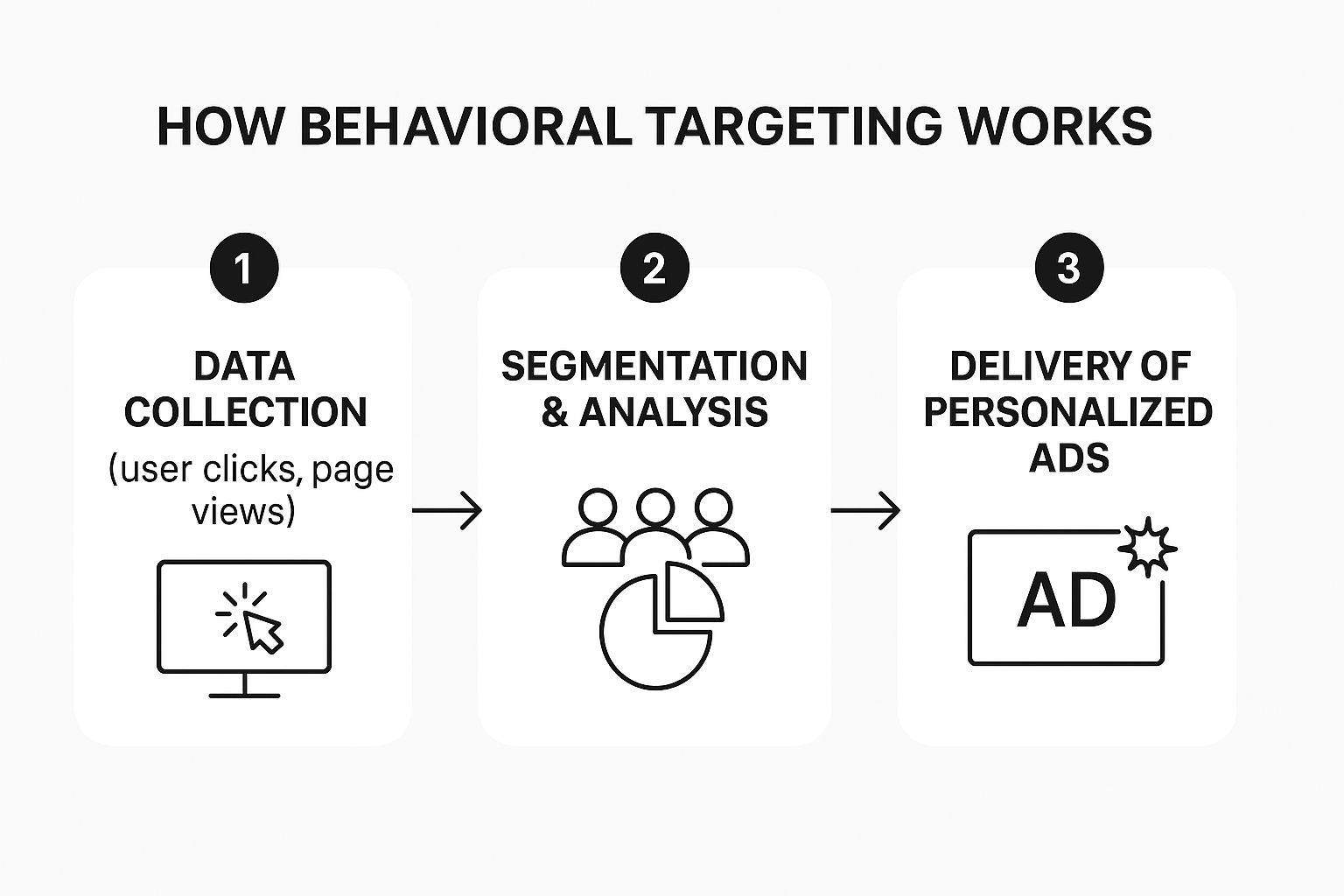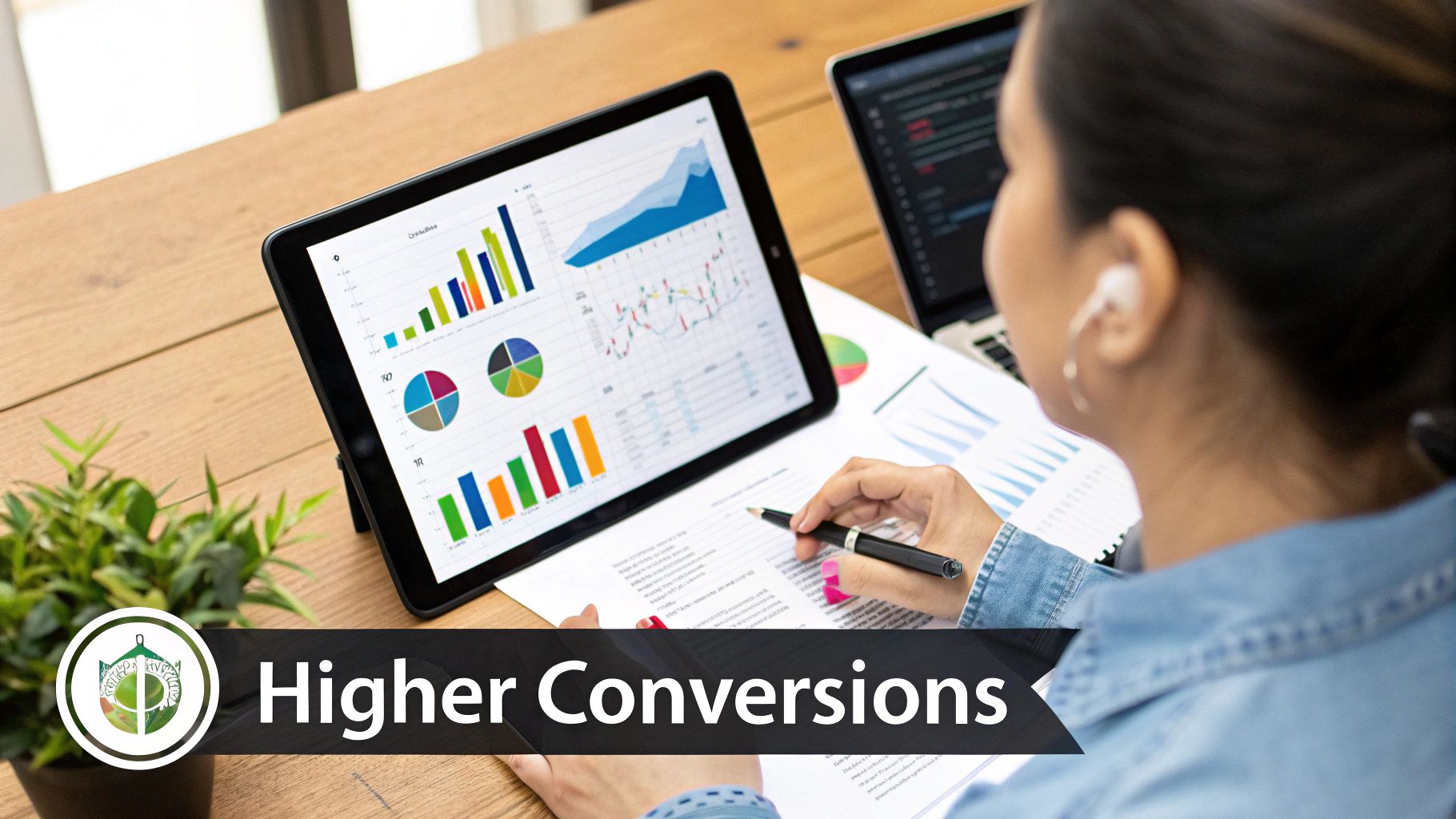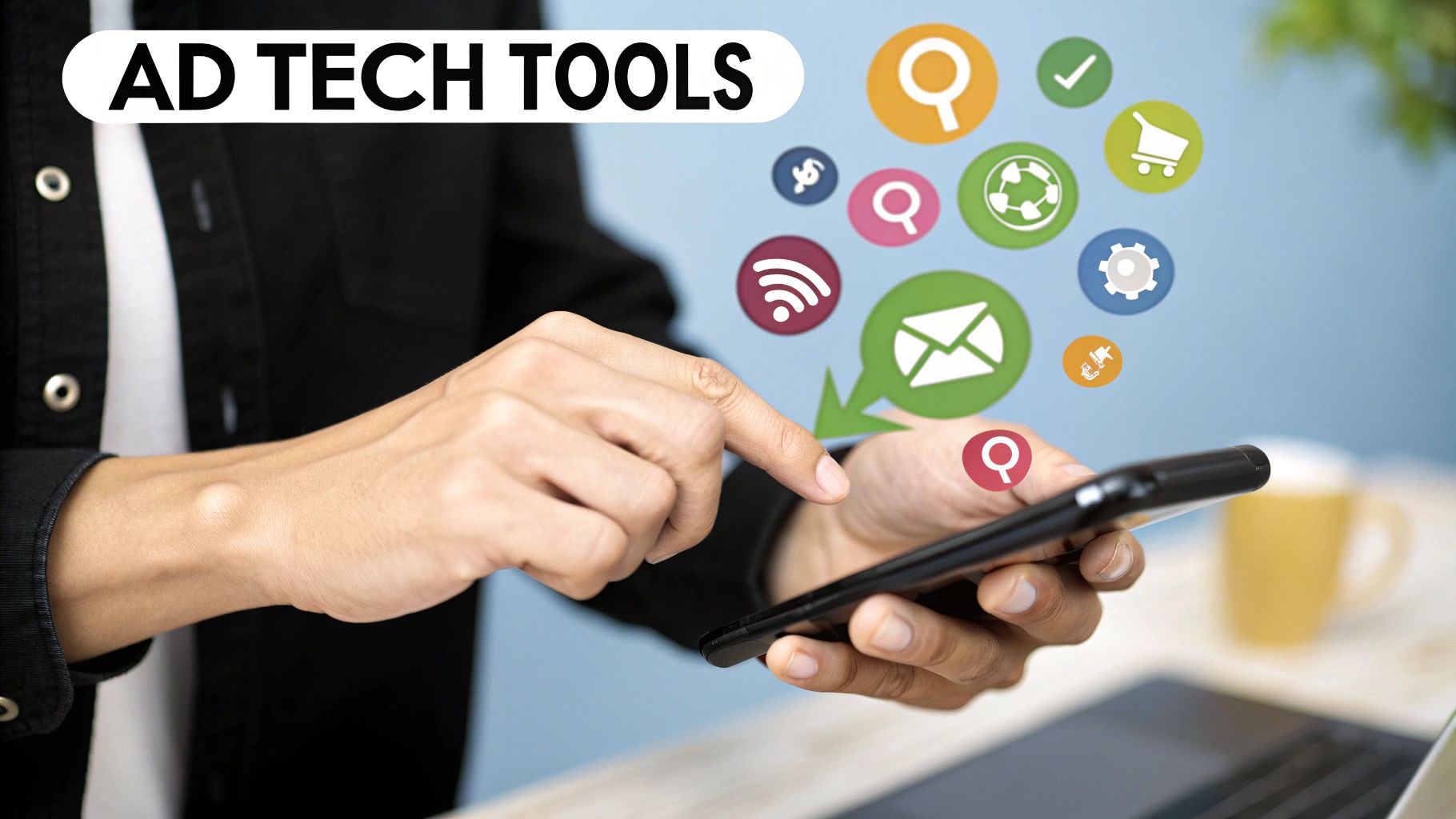Let's be honest, we've all been on the receiving end of a marketing campaign that completely misses the mark. It feels like you're shouting into a void, hoping someone—anyone—listens. What is behavioral targeting? It’s the exact opposite of that. It’s a smart strategy built on showing people hyper-relevant marketing based on their actual actions: what they click, view, and buy.
Think of it as the difference between a generic "20% off everything!" email blast and a perfectly timed WhatsApp message about the exact pair of sneakers a customer just viewed for the third time. One gets ignored; the other feels like a helpful nudge. In this playbook, you'll learn exactly how to use this powerful strategy to drive real revenue for your brand.
Why Generic Marketing Is Costing You Sales

If you're running an e-commerce store, you know the pressure is always on. Margins are tight, competition is fierce, and every marketing dollar needs to pull its weight. A common mistake we see is brands spending a huge chunk of their budget on one-size-fits-all campaigns. This approach doesn't just burn cash; it actively alienates potential customers with offers they couldn't care less about.
The Problem With "Spray and Pray"
The old "spray and pray" method is officially dead. Today's shoppers don't just want personalization—they expect it. When a message lands in their inbox that has nothing to do with their interests, they don't just ignore it. They get annoyed. This frustration leads directly to abysmal engagement, poor conversion rates, and a shrinking customer lifetime value (LTV).
Behavioral targeting, on the other hand, acts like a smart personal shopper for every single person who visits your site. By paying attention to what users do, you can understand what they want and meet them at just the right moment with the perfect message. The numbers back this up: behaviorally targeted ads can generate 2.7 times more revenue per ad compared to their non-targeted counterparts. You can dig into more data on behavioral targeting effectiveness to see just how powerful this shift can be for your ROI.
The Kanal Expert Take: From our experience with over 500 Shopify stores, the moment a brand switches from generic email blasts to behavior-triggered WhatsApp flows, metrics like cart recovery and repeat purchase rates jump. It’s about creating a conversation, not just shouting a promotion.
The Core Idea Behind Behavioral Targeting
To really understand what is behavioral targeting, it helps to think of it as a strategy built on three simple pillars:
- Observation: Watching user actions like pages viewed, items added to a cart, past purchases, and even how long they linger on a product page.
- Understanding: Analyzing this data to figure out a customer's interests, their intent to buy, and where they are in their shopping journey. Are they just browsing, or are they serious about making a purchase?
- Action: Sending a personalized message or offer based on that specific behavior. This could be a friendly cart recovery reminder on WhatsApp, a helpful cross-sell suggestion after a purchase, or a special offer for a loyal VIP customer.
Let's break down the types of data you'll be working with.
Behavioral Targeting At a Glance
The table below gives you a quick summary of the key data types used in behavioral targeting and what they reveal about your customers.
By combining these data points, you get a rich, multi-dimensional view of each person, allowing you to move beyond guesswork and into truly personal communication.
This guide will walk you through exactly how to leave expensive, ineffective marketing behind and adopt this precise, high-return strategy. We'll break down all the core components and show you how to turn customer actions into predictable sales for your brand.
How Behavioral Targeting Works in the Real World
The technology driving behavioral targeting can sound technical, but the idea behind it is actually simple. After helping hundreds of Shopify stores get this up and running, we’ve found it’s easiest to break it down into a three-step process: Data Collection, Segmentation, and Activation.
Let's walk through how these pieces fit together to help you turn a casual browser into a loyal customer.
Step 1: Data Collection
This is your foundation. Every time someone interacts with your online store, they leave behind digital breadcrumbs. This first step is all about scooping up those signals.
Tools like the Meta Pixel are like the eyes of your digital storefront. Once you have it properly installed on your Shopify site, it starts tracking key events:
- Page Views: Which specific product or category pages someone looks at.
- Time on Page: How long they stick around to consider an item.
- Add to Cart: A huge indicator of real buying intent.
- Initiate Checkout: The strongest signal you can get before a purchase is made.
It's important to remember this isn't about collecting sensitive personal info. It’s about understanding shopping patterns so you can make the experience better for everyone. If you're curious about the bigger picture here, this guide on Artificial Intelligence in Marketing is a great read.
This flow chart gives you a quick visual of how a simple click can become a personalized message.

As you can see, the whole process kicks off with user actions. Those actions are then analyzed to create smart groups, which is what lets you deliver the right message at the perfect time.
Step 2: Segmentation
Once you have the data, the next job is to make it useful. Segmentation is just a fancy term for grouping users into audiences based on what they did. This is where you stop seeing anonymous traffic and start seeing clear customer profiles emerge.
The Kanal Expert Take: A common mistake we see is brands collecting data but never putting it to work. The real goal is to map specific behaviors to different stages of the buying journey. Smart, dynamic lists are your secret weapon.
For instance, you could create segments like:
- High-Intent Browsers: People who viewed a product more than three times in one week.
- Cart Abandoners: Shoppers who added an item to their cart but bailed before checkout.
- VIP Customers: Loyal customers who have spent over a set amount, like $500, in the last six months.
- Recent Buyers: Anyone who made a purchase in the last 30 days.
Getting a handle on how to group these users is fundamental to your success. In fact, we put together a whole guide on how to create a customer journey map that goes much deeper into this part of the process.
Step 3: Activation
This is where your insights turn into actual revenue. Activation means automatically sending a personalized message or offer the moment a user lands in one of your segments. It’s the "action" part of the whole process.
Let's say a customer joins your "Cart Abandoners" segment. Instead of just hoping they come back, an automated workflow can instantly fire off a helpful WhatsApp message through Kanal, reminding them what they left behind. That right there is behavioral targeting in action—a timely, relevant, and genuinely helpful nudge.
The 4 Core Behavioral Segments for E-Commerce Growth

Theory is one thing, but let's get down to what actually moves the needle. After working with hundreds of e-commerce brands, we’ve learned you don't need to juggle dozens of complicated segments to get results. In fact, focusing on these four core behavioral groups is the strategy that consistently delivers the biggest bang for your buck.
This is exactly how you can turn the idea of what is behavioral targeting into a real, money-making system for your store.
1. On-Site Engagement
Think of this group as your digital "window shoppers." They're the people who show clear interest but haven't pulled the trigger yet. Maybe they're browsing specific product categories, spending a lot of time on certain pages, or coming back to view the same item over and over. Every click is a signal telling you what they want.
A huge mistake we see brands make is just letting this high-intent traffic walk away. Don't let them! Instead, use a tool like Kanal to automatically send a WhatsApp message to someone who, for instance, viewed a pair of shoes three times without adding them to their cart.
Example WhatsApp Message: "Hey [Customer Name]! Saw you were checking out our new running shoes. We just put together a lookbook of our best-selling athletic gear. Want to take a peek?"
2. Purchase History
Your existing customers are an absolute goldmine. This segment is all about understanding their past buying habits—what they’ve bought, how often they come back, and what their average order value (AOV) looks like. This data doesn't just tell you about the past; it helps you predict what they’ll want next and pinpoint who your most valuable shoppers are.
From here, you can build out incredibly powerful sub-segments like your “VIPs” (the high spenders) or your “One-Time Buyers” that you want to coax back for a second purchase. Getting a handle on these groups is the secret to boosting customer lifetime value (LTV)—which is the total revenue a business can expect from a single customer account.
To figure out what your best customers are truly worth, you can use our free customer lifetime value calculator. Knowing those numbers makes it so much easier to justify creating special offers exclusively for them.
3. Cart and Checkout Abandonment
This is the lowest-hanging fruit in e-commerce. Full stop. These are people who were literally seconds away from giving you their money. They put items in their cart, maybe even started filling out their shipping info, and then… something stopped them. It could have been anything—a surprise shipping cost, a phone call, or just a moment of hesitation.
Your job is to gently nudge them back over the finish line. A direct channel like WhatsApp, with its 98% open rate, is perfect for this. The strategy that consistently delivers the best results for our clients is a multi-step cart recovery flow that offers help first, followed by a small incentive if they still need a push.
4. Device and Location Data
How and where a customer shops gives you crucial context for your marketing. Someone browsing on their phone during a lunch break is in a completely different mindset than a person shopping from their desktop computer at home.
Likewise, knowing a customer's location allows you to send geographically relevant offers. Think promoting winter coats to shoppers in colder climates or surf gear to those near the coast.
Diving into these segments can also spark some fantastic customer loyalty program ideas that build stronger relationships and keep people coming back. For example, why not send a special invitation for an in-store event to VIP customers who live near one of your physical retail locations? It’s that extra layer of personalization that proves you’re paying attention.
Supercharging Your WhatsApp Marketing with Behavioral Data
Alright, you've got the basics of behavioral segments down. Now for the exciting part: connecting those powerful insights to the direct, personal world of WhatsApp. This is where theory meets reality, and you start seeing a genuine impact on your bottom line. When you pair smart targeting with WhatsApp's mind-blowing 98% open rates, the results speak for themselves.
Let’s shift gears from what it is to how you can actually do it with Kanal. I'm going to walk you through three high-impact automated flows that we've seen deliver fantastic results for our clients time and time again.
The High-Intent Cart Recovery Flow
This isn't your average, run-of-the-mill cart recovery message. A classic mistake I see all the time is treating every abandoned cart as if it's the same. It's not. This flow is smarter, targeting shoppers who showed extra intent—maybe they viewed a product multiple times or spent several minutes on the page before adding it to their cart and then bouncing.
These customers are right on the edge. A timely, helpful nudge on a personal channel like WhatsApp is often the only thing standing between an abandoned cart and a completed sale.
Proven WhatsApp Template: "Hi [Customer Name]! It looks like you left the [Product Name] in your cart. It’s one of our best-sellers! Do you have any questions about sizing or shipping I can help with? Happy to help!"
See the difference? This feels like a helpful customer service rep reaching out, not a pushy, automated sales pitch. It starts a conversation, which is the secret to building trust and, ultimately, recovering that sale.
The Post-Purchase Cross-Sell Flow
The moments right after a customer clicks "buy" are pure gold. Their trust in your brand is at an all-time high, and they're genuinely excited about their order. This is the absolute perfect time to suggest a complementary product that makes their original purchase even better.
The strategy that consistently gets the best results for our clients is simple: wait 24-48 hours, then send a helpful suggestion based on what they just bought. The growth of behavioral targeting is deeply connected to technology, with AI and machine learning making this kind of precision possible. These tools let you segment audiences based on real-time engagement, not just old-school demographics, which dramatically improves campaign results. You can dive deeper into how technology is shaping the industry by exploring the latest research on the behavioral targeting market.
Let's look at how this plays out in a real-world scenario. Here's a real-world example from a brand we work with.
Generic Marketing vs. Behavioral WhatsApp Marketing
The behavioral approach isn't just a different message; it's a completely different conversation. It shows you're paying attention to the customer's journey, not just trying to sell them more stuff.
The VIP Re-engagement Flow
Your best customers deserve your best efforts. This flow is all about identifying and rewarding your VIPs—the people who buy from you often or have a high lifetime value (LTV). Honestly, nurturing this group is the most reliable way to build long-term, predictable revenue. We've seen clients increase their LTV by over 25% using this exact strategy.
With Kanal, you can automatically segment these users based on their spending habits and purchase history. Here’s a peek at what RFM (Recency, Frequency, Monetary) segmentation looks like inside the platform, helping you pinpoint your champion customers.
This visual breakdown makes it incredibly easy to see who your most valuable customers are so you can create campaigns just for them. These flows are built on the same principle as making a great first impression, a topic we explore in our guide on how to master customer onboarding automation.
VIP WhatsApp Template: "Hey [Customer Name]! As one of our most valued customers, we wanted to give you early access to our new collection before anyone else. Here’s a private link to shop now. Thanks for being part of the family!"
This kind of exclusive, behavior-driven message makes your best customers feel seen and truly appreciated. That's how you turn happy customers into passionate, lifelong brand advocates.
Building Customer Trust Through Ethical Targeting
Let's tackle the elephant in the room: privacy. For many customers, the idea of "behavioral targeting" can sound a bit unnerving. As a brand, getting this right isn't just a good idea—it's everything.
We’ve seen it time and again: ethical data practices aren't a chore; they're a brand-building superpower. As an official Meta Business Partner, our philosophy at Kanal is simple: smart targeting should always feel helpful, never creepy. It all comes down to building unshakable trust. When customers trust you, they buy from you, stick around, and even tell their friends about you.

Pillar 1: Radical Transparency
First things first, you have to be completely upfront about how you use customer data. A clear, easy-to-read privacy policy is non-negotiable. This isn't the place for confusing legal jargon.
Write in clear, simple language. Your paragraphs should be short. Simply tell your customers what information you collect and, more importantly, how it helps you give them a better shopping experience. This kind of honesty builds a foundation of trust that pays off in spades with customer loyalty.
Pillar 2: The Power of Opt-In
This is where a platform like WhatsApp really stands out. Unlike many other channels, communication on WhatsApp is based on explicit consent. A customer has to actively opt-in to hear from you, which completely changes the nature of the conversation.
From our experience: This user-initiated model is a game-changer. When someone gives you their number and permission to message them, they're already in a more trusting mindset. They are inviting you into their personal space—a responsibility we take seriously.
This creates a highly trusted channel where your messages feel like a welcome conversation, not a random interruption.
Pillar 3: Delivering Genuine Value
Finally, and this is the golden rule, every single message you send must deliver real, tangible value. If your message solves a problem, anticipates a need, or offers something genuinely relevant, it's not just marketing; it's great customer service.
Targeting only feels creepy when the message is irrelevant or self-serving. This value-first approach is the key to balancing personalization with privacy. The global market trends back this up; while North America currently leads in behavioral targeting, Europe's growth is heavily influenced by strict regulations like GDPR that put consumer consent first. You can learn more about this global market dynamic and see why a privacy-first strategy is just smart business.
When you nail these three pillars, you don’t just address privacy concerns—you turn them into a competitive advantage. You prove that you respect your customers, and in return, you earn their lasting trust and loyalty.
Start Your First Behavioral Campaign in 3 Simple Steps
Alright, theory is great, but let's get down to business. Putting behavioral targeting into practice is where you'll see the real impact on your revenue. We've made this process as straightforward as possible so you can get up and running quickly.
Here’s your game plan.
Your Quick-Start Plan
Think of this as your launch checklist. Follow these three steps, and you'll have your first behavior-based campaign driving sales in no time.
Check Your Meta Pixel: First, your Meta Pixel is the heart of your data collection. You need to be sure it’s installed correctly on your Shopify store. Double-check that it’s actively tracking crucial events like "Add to Cart" and "View Content." Without this data, you're flying blind.
Install Kanal & Connect WhatsApp: Now, head over to the Shopify App Store and install the Kanal app. The entire setup process is designed to be fast—it usually takes less than 10 minutes. This step seamlessly links your WhatsApp Business Account to all that valuable customer data flowing from your store.
Launch Your First Automated Flow: We’ve worked with over 500 Shopify stores, and I can tell you with certainty: the Abandoned Cart recovery flow delivers the fastest and most significant return. Start there. Use one of our proven, pre-built templates to get your campaign live in just a few clicks. If you're ready to explore more advanced tactics, our guide on how to set up marketing automation has you covered.
The Kanal Expert Take: That’s honestly it. The biggest mistake merchants make is overthinking things. Don't aim for perfection on day one. Launching a single, solid, behavior-driven flow is infinitely more valuable than spending weeks planning ten of them. You have the knowledge—now go turn it into growth.
Diving Deeper: Your Behavioral Targeting Questions Answered
Even after seeing the benefits, it’s natural to have a few questions before you jump in. Let's tackle some of the most common ones we hear from merchants who are just getting started with behavioral targeting. The goal here is to clear up any confusion so you can feel confident putting these ideas into practice.
Is Behavioral Targeting Just Another Name for Contextual Targeting?
Not at all, and understanding the distinction is key.
Contextual targeting is about the environment. Think of it like seeing an ad for running shoes in a fitness magazine. The ad is there because the magazine's content is about fitness. It’s targeting the page, not the person reading it.
Behavioral targeting, on the other hand, is all about the individual. It follows a specific person's digital breadcrumbs—like the products they clicked on last week or the items they added to their cart—to show them relevant ads wherever they go online. It’s a much more personal and, frankly, more powerful approach.
Won't This Feel a Little Creepy to My Customers?
This is probably the biggest hesitation we see, but the honest answer is: it's only creepy if you make it creepy. The secret lies in creating a fair value exchange.
From what we've seen, customers only get weirded out when the ads feel aggressive, completely irrelevant, or offer them absolutely nothing in return.
As long as your messages are genuinely helpful, customers tend to welcome them. A timely discount on a product they were just looking at, a helpful reminder about their abandoned cart, or a follow-up with related items they might love—that’s not creepy, that’s just great customer service.
How Much Data Do I Really Need to Make This Work?
You probably need less than you think. This is a common worry, but you don't need a massive, years-old customer database to start seeing results.
Even with modest website traffic, you can implement some incredibly effective automated campaigns that deliver a fantastic return right out of the gate. You should start with these:
- A Welcome Series: Greet new subscribers and make a great first impression.
- Cart Abandonment Reminders: Recoup sales from shoppers who were this close to buying.
- Post-Purchase Follow-ups: Turn one-time buyers into repeat customers.
Your targeting will absolutely get smarter and more precise as you gather more data over time. But launching these foundational campaigns is something we help brands do on day one, and they start paying for themselves almost immediately.
In summary, understanding what is behavioral targeting is about seeing your customers' actions as a conversation. By listening to what they do, you can respond with timely, relevant, and valuable messages that build trust and drive sales.
Ready to put these insights into action and build your own high-converting flows?
Install Kanal on your Shopify store today and see the results for yourself.



